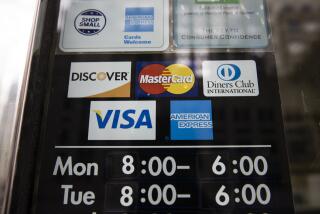Corporate Credit Quality Sliding
- Share via
In a still-stellar U.S. economy, one warning light is blinking on Wall Street: a deterioration in corporate credit quality--companies’ ability to repay their bond debt.
Credit quality is expected to worsen in the third quarter, continuing a trend that began in the spring of 1998.
The problems are still modest, which is why investors aren’t fleeing high-yield corporate junk bonds or junk bond mutual funds in fear. Still, “this is a broad-based trend,” said Nick Riccio, a managing director at bond rater Standard & Poor’s Corp. in New York.
The trend is manifested in the number of upgrades versus downgrades of corporate bond quality ratings. Analysts expect downgrades to outnumber upgrades in the third quarter, as they did in the current quarter, the first quarter and the second half of 1998.
Analysts also predict that default rates--the number of companies missing bond interest or principal payments because of financial trouble--will continue to creep up.
Moody’s Investors Service, another major bond rater, said the default rate on the speculative-grade (i.e., junk) bonds it tracks has risen every month this year. On a trailing 12-month basis, 4.3% of junk bond issuers were in default as of May, up from 3.5% in January and the highest since 4.6% in July 1993.
Why are default rates rising if business is so good? The height of the global financial crisis late last summer helped fuel the trend, as frightened investors suddenly demanded sky-high yields on new junk bonds.
That effectively priced many companies out of the market temporarily. Those that badly needed to roll over existing debt thus may have found themselves in a cash crunch.
The market has since improved. Average junk yields, as tracked by KDP Investment Advisors, dropped from nearly 10.75% in October to just above 9% in early April.
But yields have risen again in recent weeks as the market reacted to expectations that the Federal Reserve will raise its benchmark short-term interest rate. The KDP average junk yield now is 9.92%.
Even so, some analysts think the credit-quality picture will brighten. Even with rising default rates, more than 95% of junk bond borrowers are paying on time, optimists note.
And the market overall comprises a far larger number of borrowers now than in 1993, as borrowing has surged in recent years.
Sean Keenan, a senior analyst with Moody’s, argues that “the default rate should not go much higher, barring any deterioration in borrowing conditions.” In fact, he thinks defaults might begin to lessen later this year.
More to Read
Inside the business of entertainment
The Wide Shot brings you news, analysis and insights on everything from streaming wars to production — and what it all means for the future.
You may occasionally receive promotional content from the Los Angeles Times.










